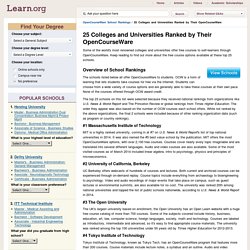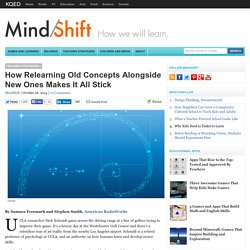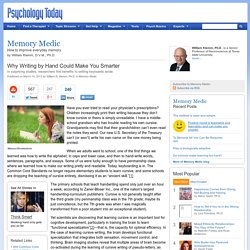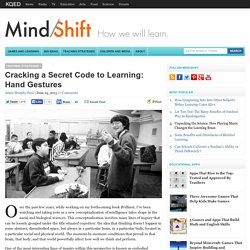

25 Colleges and Universities Ranked by Their OpenCourseWare. Some of the world's most renowned colleges and universities offer free courses to self-learners through OpenCourseWare.

Keep reading to find out more about the free course options available at these top 25 schools. The schools listed below all offer OpenCourseWare to students. OCW is a form of learning that lets students take courses for free via the Internet. Students can choose from a wide variety of course options and are generally able to take these courses at their own pace. None of the courses offered through OCW award credit. The top 23 schools on this list were selected because they received national rankings from organizations like U.S. . #1 Massachusetts Institute of Technology MIT is a highly ranked university, coming in at #7 on U.S. . #2 University of California, Berkeley UC Berkeley offers webcasts of hundreds of courses and lectures. . #3 The Open University #4 Tokyo Institute of Technology #5 Middle East Technical University #6 Delft University of Technology #7 Stanford University.
How Relearning Old Concepts Alongside New Ones Makes It All Stick. iStock By Samara Freemark and Stephen Smith, American RadioWorks UCLA researcher Dick Schmidt gazes across the driving range at a line of golfers trying to improve their game.

It’s a breezy day at the Westchester Golf Course and there’s a relentless roar of jet traffic from the nearby Los Angeles airport. Schmidt is a retired professor of psychology at UCLA, and an authority on how humans learn and develop motor skills. As Schmidt watches the golfers practice the same swing with the same clubs, over and over, he chuckles.
“I give conference presentations to golf instructors and professionals,” Schmidt said. Schmidt explains that repetitive drilling on the same task is called “block practice.” Tim Lee draws a five-iron from his bag to demonstrate. “So I might try to hit a knockdown shot to start with, and then I might try a hook and then a slice,” Lee said. Lee recently retired from McMaster University in Canada. Bjork studies interleaving in his psychology lab at UCLA. Do You have the Personality To Be an Inquiry-Based Teacher? By Thom Markham So far, the challenges of transforming education into a system capable of inspiring students to become skillful, creative, knowledgeable problem-solvers fall into familiar territory: What types of curriculum, standards, skills, strategies, and adaptations to classroom teaching methods will be necessary to do this?

But it’s likely these will prove to be secondary questions. As education crosses the divide between a transmission model and an inquiry model, a more pressing issue will be apparent: How do we identify, attract, nurture, and train teachers who have an “inquiry-friendly” personality? The issue already is in view. When a teacher comes out from behind the lectern, leaves the front of the room, kneels beside a student to coach them through a problem, offers feedback designed to promote confidence and perseverance, and becomes a true partner in the learning process, the relationship between teacher and student automatically shifts. Why Writing by Hand Could Make You Smarter. Masson/Shutterstock Have you ever tried to read your physician’s prescriptions?

Children increasingly print their writing because they don’t know cursive or theirs is simply unreadable. I have a middle-school grandson who has trouble reading his own cursive. Grandparents may find that their grandchildren can’t even read the notes they send. Our new U.S. When we adults went to school, one of the first things we learned was how to write the alphabet, in caps and lower case, and then to hand-write words, sentences, paragraphs, and essays. The primary schools that teach handwriting spend only just over an hour a week, according to Zaner-Bloser Inc., one of the nation's largest handwriting-curriculum publishers. Yet scientists are discovering that learning cursive is an important tool for cognitive development, particularly in training the brain to learn “functional specialization”[2]—that is, the capacity for optimal efficiency.
. [1] Slape, L. . [3] James, K.H. and Engelhardt, L. (2013). An MIT Learning Program Challenges Many Ed-Tech Assumptions. Cracking a Secret Code to Learning: Hand Gestures. Over the past few years, while working on my forthcoming book Brilliant, I’ve been watching and taking note as a new conceptualization of intelligence takes shape in the social and biological sciences.

This conceptualization involves many lines of inquiry that can be loosely grouped under the title situated cognition: the idea that thinking doesn’t happen in some abstract, disembodied space, but always in a particular brain, in a particular body, located in a particular social and physical world. The moment-by-moment conditions that prevail in that brain, that body, and that world powerfully affect how well we think and perform. One of the most interesting lines of inquiry within this perspective is known as embodied cognition: the recognition that our bodies play a big role in how we think. Physical gestures, for example, constitute a kind of back-channel way of expressing and even working out our thoughts. There’s plenty of research to back it up. Related.